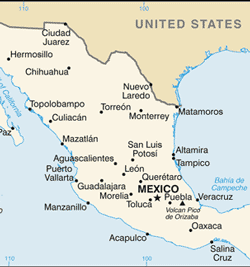By: John Shepler
Many businesses operate in both the United States and Mexico. While numerous carriers cater to each country, finding consistent service quality for both markets can be challenging.
International Connections
Businesses operating across borders require telecommunication solutions that extend internationally. Fortunately, several carriers provide international line services, including connections between US and Mexican cities.
Modern options encompass voice, data, and video services, enabling connections between two locations or the creation of a vast virtual LAN encompassing all North American business locations and beyond.
International Private Lines
The Bell Labs-developed T-Carrier system, including T1 (DS1) at 1.5 Mbps and T3 (DS3) at 45 Mbps, is widely used in North America (US, Canada, and Mexico).
Intermediate bandwidths between these standards can be achieved by bonding multiple T1 lines. However, practical limitations exist due to available copper pairs, making bonded services above 10-12 Mbps less feasible.
T3 lines offer rate limiting, allowing bandwidth adjustments between 10 Mbps and 45 Mbps. This cost-effective approach offers flexibility in utilizing the full line speed.
Notably, T1 and T3 lines are dedicated private circuits, constantly available for exclusive use. This eliminates concerns about network congestion caused by other users.
Fiber Optic International Lines
Initially developed with SONET (Synchronous Optical NETwork) standards for T-Carrier compatibility, fiber optic lines offer high bandwidth.
OC-3, the entry-level service at 155 Mbps, easily handles three T3 lines. In practice, T3 traffic is often carried over OC-3 fiber for most of the distance, with coaxial copper cable used for the final connection.
SONET remains the foundation for many wide-area networks. Beyond OC-3, common services include OC-12 (622 Mbps), OC-48 (2.5 Gbps), OC-192 (10 Gbps), and OC-768 (40 Gbps).
Similar to T-Carrier, SONET services offer dedicated bandwidth reserved solely for the customer.
Ethernet International Services
While voice traffic dominated international telecommunications for a long time, data has taken the lead, with video also exceeding voice in bandwidth usage on some networks.
This shift prompted a technological transition, with Ethernet becoming the standard for local area networks and now extending to metropolitan and wide-area networks.
EPL (Ethernet Private Line) serves as the equivalent of T-Carrier or SONET, enabling seamless LAN-to-LAN connections. This allows businesses to bridge LANs at different locations, effectively creating a single large local network.
Carrier Ethernet also offers Ethernet LAN service, a meshed network connecting three or more locations as one LAN, ideal for businesses with multiple sites.
MPLS Networks
MPLS networks frequently offer the best value for US-Mexico connections. These private “cloud” networks with national and international nodes provide virtual private lines (VPLs) and virtual private LANs (VPLANS) similar to dedicated private lines.
While sharing network infrastructure with other traffic, MPLS guarantees bandwidth, latency, jitter, and packet loss, replicating the experience of dedicated lines at a lower cost.
MPLS networks support simultaneous voice and data traffic, using class of service provisions to prioritize voice. VoMPLS (Voice over MPLS) enables VoIP services over MPLS networks, connecting multiple business locations.
For businesses with US-Mexico connectivity needs, exploring international private lines and MPLS network options is recommended.


